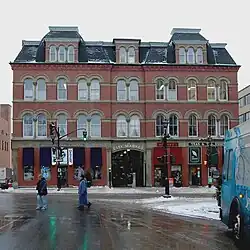Saint John, New Brunswick
Saint John is a seaport city located on the Bay of Fundy in the province of New Brunswick, Canada. It is Canada's oldest incorporated city,[lower-alpha 2] established by royal charter on May 18, 1785, during the reign of George III.[9] The port is Canada's third-largest port by tonnage with a cargo base that includes dry and liquid bulk, break bulk, containers, and cruise.[10] The city was the most populous in New Brunswick until the 2016 census, when it was overtaken by Moncton. It is currently the second-largest city in the province, with a population of 69,895 over an area of 315.59 km2 (121.85 sq mi).[11]
Saint John | |
|---|---|
| The City of Saint John[lower-alpha 1] | |
 From top, left to right: Saint John skyline, Imperial Theatre, Germain Street row houses, Reversing Falls, City Market, St. Martins covered bridge | |
 Coat of arms  Logo | |
| Nicknames: | |
| Motto(s): "O Fortunati Quorum Jam Moenia Surgunt" (Latin for, "O Fortunate Ones Whose Walls Are Now Rising." or "O Happy They, Whose Promised Walls Already Rise") | |
 Saint John Location of Saint John 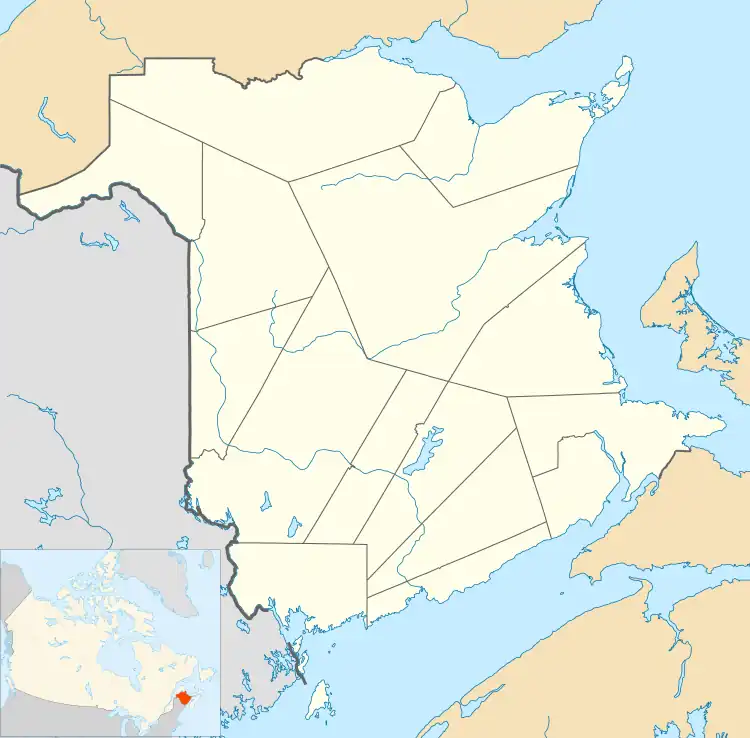 Saint John Saint John (New Brunswick) | |
| Coordinates: 45°16′50″N 66°04′34″W | |
| Country | Canada |
| Province | New Brunswick |
| Historic countries | Kingdom of France Kingdom of Great Britain United Kingdom of Great Britain and Ireland |
| County | Saint John |
| Parish | City of Saint John[2] |
| Founded on | June 24, 1604[3] |
| Major Settlement Started | 1783[3] |
| Incorporation | May 18, 1785 |
| Named for | Saint John River |
| Government | |
| • Mayor | Donna Reardon |
| • Governing body | Saint John City Council |
| • MPs | Wayne Long |
| • MLAs | Trevor Holder, Gerry Lowe, Dorothy Shephard, Glen Savoie |
| Area | |
| • Land | 315.59 km2 (121.85 sq mi) |
| • Urban | 70.05 km2 (27.05 sq mi) |
| • Metro | 3,505.66 km2 (1,353.54 sq mi) |
| Highest elevation | 80.8 m (265.1 ft) |
| Lowest elevation | 0 m (0 ft) |
| Population (2021) | |
| • City | 69,895[4] |
| • Density | 221.5/km2 (574/sq mi) |
| • Urban | 63,447[5] |
| • Urban density | 905.8/km2 (2,346/sq mi) |
| • Metro | 130,613[6] |
| • Metro density | 37.3/km2 (97/sq mi) |
| • City Pop 2016-2021 | |
| • Dwellings | 31,825 |
| Demonym(s) | Saint Johner, Saint-Jeannois(e), Johner (colloquial) |
| Time zone | UTC−04:00 (AST) |
| • Summer (DST) | UTC−03:00 (ADT) |
| Canadian Postal code | E2H, E2J, E2K, E2L, E2M, E2N, E2P, E2R, and E2S |
| Area code | 506 |
| Telephone exchanges | 202, 214, 333, 343, 557–8, 592, 608, 631–640, 642–654, 657–8, 663, 672, 674, 693–4, 696, 721, 977 |
| Highways | |
| NTS Map | 21G8 Saint John |
| GNBC Code | DAEGW[7] |
| GDP (Saint John CMA) | CA$6.4 billion (2016)[8] |
| GDP per capita (Saint John CMA) | CA$51,021 (2016) |
| Website | saintjohn |
French explorer Samuel de Champlain landed at Saint John Harbour on June 24, 1604 (the feast of St. John the Baptist) and is where the Saint John River gets its name; the indigenous Mi'kmaq and Wolastoqiyik peoples called the river "Wolastoq". The Saint John area was an important area for trade and defence for Acadia during the French colonial era, and Fort La Tour, in the city's harbour, was a pivotal battleground during the Acadian Civil War.[12]
After more than a century of ownership disputes between the French and English over the land surrounding Saint John, the British government deported the Acadians in 1755 and constructed Fort Howe above the harbour in 1779. In 1785, the City of Saint John was established by uniting the two communities of Parrtown and Carleton on each side of the harbour after the arrival of thousands of refugees from the newly founded United States who wished to remain British after the American Revolution. During the next century, immigration via Partridge Island, especially during the Great Famine, would fundamentally change the city's demographics and culture.
History

The area has been the home of peoples of the Wabanaki Confederacy for thousands of years. The northwestern coastal region of the Bay of Fundy inhabited by the Passamaquoddy Nation, while the Saint John River valley north of the bay became the domain of the Wolastoqiyik Nation. The Mi'kmaq also ventured into the Saint John area regularly as the harbour and coast was an important hunting ground for seals. The area around the harbour, where the city is, has been traditionally called Menahkwesk by the Wolastoqiyik people, who still live in and around the city today. In pre-colonial times the Wolastoqiyik lived in mostly self-sustaining villages living largely off bass, sturgeon, salmon, corn, wild roots and berries.[13]
Samuel de Champlain landed at Saint John Harbour in 1604, though he did not settle the area. Saint John was a key area for trade and defence for Acadia during the French colonial era. Fort La Tour in the city's harbour, was a pivotal battleground during the Acadian Civil War.[12] At the end of the Seven Years' War, the British took the region from the French.
The population grew with immigration from the former Thirteen Colonies and Europe. In 1785, Saint John became the first incorporated city in what is now Canada.[9] Immigration led to the building of North America's first quarantine station, Partridge Island.[14]
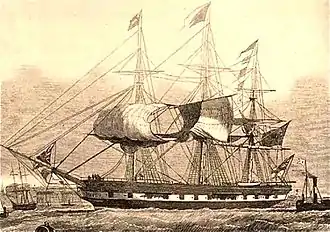
The city became a shipyard of global stature. The 1851 ship Marco Polo became the fastest in the world,[15] and Robert Foulis developed the automated foghorn.[16]

As the city grew in strategic importance to English power and capital, unrest grew among many of its working class. Black Saint Johners were forbidden to engage in trade, fishing or voting; thus the majority of the city's Black community settled in Portland (the city's north end), which later became amalgamated with Saint John.[13] In 1849, Canada's first labour union, the Laborer's Benevolent Association (now ILA local 273) was formed by longshoremen.[17] From 1840 to 1860 sectarian violence was rampant in Saint John, as tensions grew in reaction to poor living conditions of poor Irish Catholics resulting in some of the worst urban riots in Canadian history.[18] The city experienced a cholera outbreak in 1854 with the death of over 1,500 people,[19] as well as a great fire in 1877 that destroyed 40% of the city and left 20,000 people homeless with damage exceeding $10 million (a modern value of approximately $256 million).[20][21]
Geography and climate
Physical geography

Situated in the south-central portion of the province, along the north shore of the Bay of Fundy at the mouth of the Saint John River, the city is split by the south-flowing river and the east side is bordered on the north by the Kennebecasis River where it meets the Saint John River at Grand Bay. Saint John Harbour, where the two rivers meet the Bay of Fundy, is a deep water port and ice-free all year long. Partridge Island is in the harbour. The city land area is 315.96 km2 (121.99 sq mi), and the metropolitan area covers 3,509.62 km2 (1,355.07 sq mi).[22]
Stonehammer UNESCO Geopark, the first Geopark in North America, is centred around Saint John. The Geopark has been recognized by UNESCO as having exceptional geological significance. The park contains rock formations that date back to the Precambrian era and some of the rocks may be a billion years old.
The Saint John River itself flows into the Bay of Fundy through a narrow gorge several hundred metres wide at the centre of the city. It contains a unique phenomenon called the Reversing Falls where the diurnal tides of the bay reverse the water flow of the river for several kilometres. A series of underwater ledges at the narrowest point of this gorge also create a series of rapids.
The topography surrounding Saint John is hilly; a result of the influence of two coastal mountain ranges which run along the Bay of Fundy – the St. Croix Highlands and the Caledonia Highlands. The soil throughout the region is extremely rocky with frequent granite outcrops. The coastal plain hosts numerous freshwater lakes in the eastern, western and northern parts of the city.
In Saint John the height difference from low to high tide is approximately 8 metres (28 ft) due to the funnelling effect of the Bay of Fundy as it narrows. The Reversing Falls in Saint John, actually an area of strong rapids, provides one example of the power of these tides; at every high tide, ocean water is pushed through a narrow gorge in the middle of the city and forces the Saint John River to reverse its flow for several hours.
Architecture

Saint John, especially in its Uptown region, features a multitude of architectural styles spanning from the 19th and early 20th centuries, with residences and buildings containing Victorian, Romanesque Revival, and Second Empire architectural styles.[23] During the late 19th to early 20th centuries, the most popular styles in the city were Queen Anne and Romanesque architecture. In 1911, a proposed city hall was to share Gothic and Second Empire architectural styles. Overtime, the city would no longer adopt some of these styles.[24] Buildings in Saint John also feature stone carvings and sculptures.[25][26]
List of buildings in Saint John:
- Courtney Bay Smokestacks (each 106.7 m (350 ft))
- Brunswick Square (80.8 m (265 ft)) 19-storey office tower with 511,032 sq ft (47,476.4 m2) which was built in 1976. It is the largest office building in New Brunswick in terms of square footage and second in Atlantic Canada behind the Maritime Centre in Halifax.
- Cathedral of the Immaculate Conception (Gothic style Catholic cathedral, construction began in 1853, its spire rises to 70.1 m (230 ft))
- City Hall (55.2 m (181 ft)) 15-storey office building (165,000 sq ft (15,300 m2))
- Brunswick House (52 m (171 ft)) 14-storey office building (103,000 sq ft (9,600 m2))[27]
- Irving Building (50 m (160 ft)) 14-storey office building[28]
- Harbourside Senior Citizens Housing Complex (43 m (141 ft)) 12-storey apartment building
- Harbour Building (37 m (121 ft)) 10-storey office building
- Mercantile Centre (30 m (98 ft)) 7-storey office building (106,600 sq ft (9,900 m2))[29]
- Chateau Saint John 8-storey hotel (112 rooms)[30]
- City Market (built in 1876, oldest city market in North America, with an original ship's hull roof design)
- Loyalist House (built in 1817)
- Irving Oil Headquarters (2019) 11-storey office building
Parks and nature
Saint John is home to the historic King's Square, an urban park located in the city's Uptown region.[31] multiple historic buildings are located by the park, including the Saint John City Market, the Imperial Theatre, as well as the former Admiral Beatty Hotel. Also located in Saint John is the Irving Nature Park, located in the city's west side and measuring 600 acres (240 hectares).[32][33]
Neighbourhoods
According to Saint John mapping data, the city has 33 neighborhoods categorized into four groups: North, East, South and West.[34][35]
- North: North End (mostly the former city of Portland),[36] Pokiok,[37] Douglas Avenue, Churchill Boulevard, Cedar Point,[38] Millidgeville,[39] Mount Pleasant,[40] Kennebecasis Bay, and Brookville.[41][42] Cedar Point is the site of the city's only completely French school and community centre, Centre Scolaire Communautaire Samuel-de-Champlain. The area includes one of Canada's largest urban parks, Rockwood Park.
- East: East Saint John, McAllister,[43] Champlain Heights,[44] Eastwood,[45] Red Head,[46][47] Forest Hills,[48] Lakewood,[49][50] Glen Falls,[51][42] Latimer Lake,[52] and Loch Lomond.[53][54]
- South: Typically referred to as the South Central Peninsula.[55][56] Includes Uptown, Germain Street, Broad Street (although the mapping data refers to the area as Broad Street, it is commonly known as South End,[56] which formerly encompassed Lower Cove),[57] Orange Street, and Waterloo.[58] On the east side of Saint John Harbour and the area immediately opposite on the west side are the sites of the original city. Now includes the central business district and the Trinity Royal Heritage Conservation Area, which together are referred to as Uptown.
- West: Saint John West (includes Carleton),[59][60] Lower West Side,[61] Sand Cove,[62][63] Fairville,[64] Island View,[65][66] Lorneville,[67] Ocean Westway,[68] Milford-Randolph,[69][70][71] and South Bay.[72][73] Collectively referred to as West Side, but Lancaster was a notable former municipality.
Climate
| Saint John | ||||||||||||||||||||||||||||||||||||||||||||||||||||||||||||
|---|---|---|---|---|---|---|---|---|---|---|---|---|---|---|---|---|---|---|---|---|---|---|---|---|---|---|---|---|---|---|---|---|---|---|---|---|---|---|---|---|---|---|---|---|---|---|---|---|---|---|---|---|---|---|---|---|---|---|---|---|
| Climate chart (explanation) | ||||||||||||||||||||||||||||||||||||||||||||||||||||||||||||
| ||||||||||||||||||||||||||||||||||||||||||||||||||||||||||||
| ||||||||||||||||||||||||||||||||||||||||||||||||||||||||||||
The climate of Saint John is humid continental (Köppen climate classification Dfb). The Bay of Fundy never fully freezes, thus moderating the winter temperatures compared with inland locations. Even so, with the prevailing wind blowing from the west (from land to sea), the average January temperature is about −8.2 °C (17.2 °F). Summers are usually warm to hot, and daytime temperatures often exceed 25 °C (77 °F). The highest temperature recorded in a given year is usually 30 or 31 °C (86 or 88 °F). The confluence of cold Bay of Fundy air and inland warmer temperatures often creates onshore winds that bring periods of fog and cooler temperatures during the summer months.
Precipitation in Saint John totals about 1,295 mm (51.0 in) annually and is well distributed throughout the year, although the late autumn and early winter are typically the wettest time of year. Snowfalls can often be heavy, but rain is as common as snow in winter, and it is not unusual for the ground to be snow-free even in mid-winter.
The highest temperature ever recorded in Saint John was 34.4 °C (94 °F) on June 22, 1941,[75] August 15, 1944,[76] and August 22, 1976.[77] The coldest temperature ever recorded was −36.7 °C (−34 °F) on February 11, 1948.[77]
| Climate data for Saint John (Saint John Airport), elevation: 103 m (338 ft), 1981−2010 normals, extremes 1871−present[lower-alpha 3] | |||||||||||||
|---|---|---|---|---|---|---|---|---|---|---|---|---|---|
| Month | Jan | Feb | Mar | Apr | May | Jun | Jul | Aug | Sep | Oct | Nov | Dec | Year |
| Record high humidex | 16.8 | 13.3 | 27.0 | 23.8 | 35.4 | 38.0 | 40.3 | 40.3 | 39.4 | 28.3 | 24.0 | 19.8 | 40.3 |
| Record high °C (°F) | 14.5 (58.1) |
13.3 (55.9) |
25.4 (77.7) |
22.8 (73.0) |
33.0 (91.4) |
34.4 (93.9) |
33.7 (92.7) |
34.4 (93.9) |
33.9 (93.0) |
28.9 (84.0) |
21.7 (71.1) |
16.4 (61.5) |
34.4 (93.9) |
| Average high °C (°F) | −2.5 (27.5) |
−1.5 (29.3) |
2.4 (36.3) |
8.5 (47.3) |
15.0 (59.0) |
19.6 (67.3) |
22.6 (72.7) |
22.4 (72.3) |
18.2 (64.8) |
12.3 (54.1) |
6.4 (43.5) |
0.5 (32.9) |
10.3 (50.5) |
| Daily mean °C (°F) | −7.9 (17.8) |
−7.1 (19.2) |
−2.5 (27.5) |
3.7 (38.7) |
9.5 (49.1) |
14.0 (57.2) |
17.1 (62.8) |
16.8 (62.2) |
13.0 (55.4) |
7.6 (45.7) |
2.3 (36.1) |
−4.4 (24.1) |
5.2 (41.4) |
| Average low °C (°F) | −13.3 (8.1) |
−12.6 (9.3) |
−7.4 (18.7) |
−1.2 (29.8) |
3.9 (39.0) |
8.4 (47.1) |
11.6 (52.9) |
11.2 (52.2) |
7.7 (45.9) |
2.8 (37.0) |
−1.9 (28.6) |
−9.3 (15.3) |
0.0 (32.0) |
| Record low °C (°F) | −33.2 (−27.8) |
−36.7 (−34.1) |
−30 (−22) |
−16.7 (1.9) |
−7.8 (18.0) |
−2.2 (28.0) |
1.1 (34.0) |
−0.6 (30.9) |
−6.7 (19.9) |
−10.6 (12.9) |
−16.9 (1.6) |
−34.4 (−29.9) |
−36.7 (−34.1) |
| Record low wind chill | −44.8 | −44.4 | −39.5 | −26.1 | −13.9 | −2.6 | 0.0 | 0.0 | −5.7 | −12.9 | −25.9 | −41.9 | −44.8 |
| Average precipitation mm (inches) | 123.5 (4.86) |
91.0 (3.58) |
108.2 (4.26) |
105.3 (4.15) |
109.8 (4.32) |
101.0 (3.98) |
88.4 (3.48) |
81.7 (3.22) |
105.6 (4.16) |
116.4 (4.58) |
134.1 (5.28) |
130.4 (5.13) |
1,295.5 (51.00) |
| Average rainfall mm (inches) | 66.1 (2.60) |
49.0 (1.93) |
66.6 (2.62) |
85.7 (3.37) |
108.5 (4.27) |
101.0 (3.98) |
88.4 (3.48) |
81.7 (3.22) |
105.6 (4.16) |
115.8 (4.56) |
123.7 (4.87) |
84.0 (3.31) |
1,076 (42.36) |
| Average snowfall cm (inches) | 64.3 (25.3) |
48.4 (19.1) |
44.4 (17.5) |
20.0 (7.9) |
1.2 (0.5) |
0.0 (0.0) |
0.0 (0.0) |
0.0 (0.0) |
0.0 (0.0) |
0.5 (0.2) |
10.8 (4.3) |
49.9 (19.6) |
239.6 (94.3) |
| Average precipitation days (≥ 0.2 mm) | 16.2 | 12.8 | 14.0 | 13.9 | 13.7 | 12.9 | 11.5 | 10.5 | 10.5 | 11.9 | 14.4 | 15.6 | 157.9 |
| Average rainy days (≥ 0.2 mm) | 6.7 | 5.3 | 7.6 | 11.0 | 13.6 | 12.9 | 11.5 | 10.5 | 10.5 | 11.7 | 12.5 | 8.3 | 122.1 |
| Average snowy days (≥ 0.2 cm) | 12.9 | 10.2 | 9.4 | 5.1 | 0.5 | 0.0 | 0.0 | 0.0 | 0.0 | 0.5 | 3.9 | 10.2 | 52.6 |
| Mean monthly sunshine hours | 124.9 | 124.5 | 149.9 | 165.9 | 199.0 | 211.6 | 225.9 | 216.8 | 181.9 | 147.8 | 97.0 | 102.0 | 1,947.3 |
| Percent possible sunshine | 44.0 | 42.6 | 40.7 | 41.0 | 43.2 | 45.3 | 47.7 | 49.6 | 48.3 | 43.4 | 33.8 | 37.4 | 43.1 |
| Source: Environment Canada[77][78][79][80][81] | |||||||||||||
Demographics
| Year | Pop. | ±% |
|---|---|---|
| 1824 | 8,488 | — |
| 1834 | 12,073 | +42.2% |
| 1840 | 19,281 | +59.7% |
| 1851 | 22,745 | +18.0% |
| 1861 | 27,317 | +20.1% |
| 1871 | 28,805 | +5.4% |
| 1881 | 26,127 | −9.3% |
| 1891 | 39,179[note 1] | +50.0% |
| 1901 | 40,711 | +3.9% |
| 1911 | 42,511 | +4.4% |
| 1921 | 47,166 | +11.0% |
| 1931 | 47,514 | +0.7% |
| 1941 | 50,084 | +5.4% |
| 1951 | 50,779 | +1.4% |
| 1956 | 52,491 | +3.4% |
| 1961 | 55,153 | +5.1% |
| 1966 | 51,567 | −6.5% |
| 1971 | 89,039[note 2] | +72.7% |
| 1976 | 85,955 | −3.5% |
| 1981 | 80,521 | −6.3% |
| 1986 | 76,381 | −5.1% |
| 1991 | 74,969 | −1.8% |
| 1996 | 72,494 | −3.3% |
| 2001 | 69,661 | −3.9% |
| 2006 | 68,043 | −2.3% |
| 2011 | 70,063 | +3.0% |
| 2016 | 67,575 | −3.6% |
| 2021 | 69,895 | +3.4% |
| Source: [82][83][84] | ||
At the 2021 census conducted by Statistics Canada, Saint John had a population of 69,895 people that were living in 31,825 of 33,908 total private dwellings. The population density was 221.5 inhabitants per square kilometre (573.7/sq mi). The median total household income was $62,800. Of the city's population aged between 25 and 64, 24% held a bachelor's degree or higher, 58% held a postsecondary certificate, diploma or degree, and 32% had a high school diploma or equivalent. The median age was 44 years.[85]
At the census metropolitan area (CMA) level in the 2021 census, the Saint John CMA had a population of 130,613 living in 55,865 of its 59,272 total private dwellings, a change of 3.5% from its 2016 population of 126,202. With a land area of 3,505.66 km2 (1,353.54 sq mi), it had a population density of 37.3/km2 (96.5/sq mi) in 2021.[86]
Ethnicity
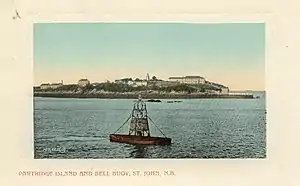
Historically, as one of Canada's main ports, Saint John has been a centre for immigration from all over the world. The city was incorporated in the late 1700s after more than 3,300 Black Loyalist refugees came to Saint John along with more than 10,000 White refugees after the American Revolution.[87] In the years between 1815 and 1867, when immigration of that era passed its peak, more than 150,000 immigrants from Ireland came to Saint John dramatically changing the city.
Those who came in the earlier period were largely tradesmen, and many stayed in Saint John, becoming the backbone of its builders. But when the Great Famine of Ireland raged between 1845 and 1849, huge waves of famine refugees flooded the city's shores. It is estimated that between 1845 and 1847, some 30,000 arrived, more people than were living in the city at the time. In 1847, dubbed "Black 47", one of the worst years of the famine, some 16,000 immigrants, most of them from Ireland, arrived at Partridge Island, the immigration and quarantine station at the mouth of Saint John Harbour.[88]
As of the 2021 census, approximately 86.4% of the residents were white, while 10.9% were visible minorities and 2.8% were Indigenous.[89] The largest visible minority groups were Black (2.7%), South Asian (2.4%), Arab (1.5%), Chinese (1.4%), and Filipino (0.9%).[89]
| Panethnic group | 2021[85] | 2016[90] | 2011[91] | 2006[92] | 2001[93] | |||||
|---|---|---|---|---|---|---|---|---|---|---|
| Pop. | % | Pop. | % | Pop. | % | Pop. | % | Pop. | % | |
| European[lower-alpha 4] | 58,875 | 86.35% | 59,480 | 90.85% | 62,940 | 92.68% | 62,780 | 94.14% | 65,375 | 95.49% |
| Indigenous | 1,895 | 2.78% | 1,430 | 2.18% | 1,560 | 2.3% | 850 | 1.27% | 640 | 0.93% |
| African | 1,820 | 2.67% | 1,400 | 2.14% | 1,200 | 1.77% | 960 | 1.44% | 1,110 | 1.62% |
| South Asian | 1,605 | 2.35% | 455 | 0.69% | 350 | 0.52% | 375 | 0.56% | 205 | 0.3% |
| Middle Eastern[lower-alpha 5] | 1,310 | 1.92% | 845 | 1.29% | 520 | 0.77% | 360 | 0.54% | 185 | 0.27% |
| East Asian[lower-alpha 6] | 1,125 | 1.65% | 1,170 | 1.79% | 880 | 1.3% | 940 | 1.41% | 460 | 0.67% |
| Southeast Asian[lower-alpha 7] | 900 | 1.32% | 360 | 0.55% | 250 | 0.37% | 215 | 0.32% | 150 | 0.22% |
| Latin American | 345 | 0.51% | 185 | 0.28% | 155 | 0.23% | 155 | 0.23% | 125 | 0.18% |
| Other/multiracial[lower-alpha 8] | 285 | 0.42% | 140 | 0.21% | 55 | 0.08% | 50 | 0.07% | 205 | 0.3% |
| Total responses | 68,180 | 97.55% | 65,470 | 96.88% | 67,910 | 96.93% | 66,690 | 98.01% | 68,465 | 98.28% |
| Total population | 69,895 | 100% | 67,575 | 100% | 70,063 | 100% | 68,043 | 100% | 69,661 | 100% |
| Note: Totals greater than 100% due to multiple origin responses | ||||||||||
Language
87.2% of residents spoke English as a mother tongue. Other common first languages were French (3.7%), Arabic (1.5%) Chinese languages (1.0%) and Tagalog (0.5%).
Religion
58.5% of residents were Christian, down from 79.6% in 2011.[94] 29.7% were Catholic, 20.6% were Protestant, 5.1% were Christian n.o.s, and 3.0% were other Christian denominations or related traditions. 36.0% of the population were non-religious or secular, up from 18.4% in 2011. Other religions accounted for 5.5% of the population, up from 2.0% in 2011. The largest non-Christian religions were Islam (3.1%) and Hinduism (1.0%).
Municipal government
Saint John is one of five chartered cities in Canada, giving it unique legislative powers.[95]
The council consists of the mayor and ten councillors.[96]
Economy

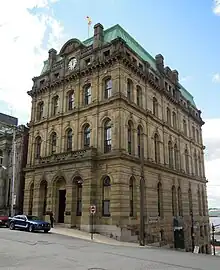
Saint John's location along the Bay of Fundy has been of major importance to the city's prosperity. The bay's dramatic tidal range prevents the harbour from icing over, allowing the city to be accessible all year round.[97] Shipbuilding, shipping and lumber trade rose as prominent industries.[98][99] By 1840, one-third of New Brunswick's timber, as well as two-thirds of its sawn lumber and manufactured wood products, were exported through Saint John.[97] At one point, Saint John was British North America's biggest shipbuilding city,[100] constructing many well-known ships, including the Marco Polo.[99] However, these industries suffered a decline in trade due to technological advancements,[101][99] which was only made worse with the Great Fire of Saint John in 1877.[99] Shipbuilding in Saint John permanently ceased in 2003 following the closure of the Saint John shipyard, which had been idle for the past three years.[102][103]
Today, Saint John benefits from industries such as tourism, reporting a tourism expenditure of $282 million in 2018.[104] Port of Saint John, the city's port, allows for a capacity of three cruise ships, and has been a cruise ship destination since 1989,[105] first welcoming the MS Cunard Princess.[106] Saint John receives around 80 cruise ships annually.[107] As of the 2023 cruise schedule, Saint John is scheduled to receive 190,680 passengers' worth of cruise ships.[108] The port also carries over 20 million metric tonnes of cargo annually.[109]
The University of New Brunswick, the New Brunswick Museum and the New Brunswick Community College are important institutions, and along with Radian6, Horizon Health Network and many others, they are a part of Saint John's fast-growing research and information-technology sectors.
Arts and culture
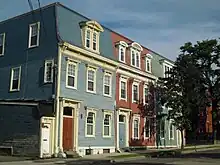
The arts and culture sector plays a large role in Saint John's economy. The Imperial Theatre is home to the highly acclaimed Saint John Theatre Company, and the Symphony New Brunswick and hosts a large collection of plays, concerts and other stage productions year-round. Harbour Station entertainment complex is home to the Saint John Sea Dogs of the QMJHL.
Art galleries in Saint John cover the uptown, more than any other Atlantic Canadian city. Artists like Miller Brittain and Fred Ross have made Uptown Saint John their home, and now the torch has been passed to artists like Gerard Collins, Cliff Turner and Peter Salmon and their respective galleries. Uptown art galleries also include the Paris Crew, Trinity Galleries, Citadel Gallery, Handworks Gallery and the Saint John Arts Centre (SJAC). The SJAC in the Carnegie Building hosts art exhibits, workshops, local songwriters' circles and other shows too small to be featured at the grand Imperial Theatre.
Heavy industry
Saint John maintains industrial infrastructure in the city's East side such as Canada's largest oil refinery as well as the country's largest dry dock. Capitalist K.C. Irving and his family built his unfettered industrial conglomerate in the city by buying up mills, shipyards, media outlets, and other industrial infrastructure during the 20th century, and still continue to this day. Today Irving dominates the city and province with stakes in oil, forestry, shipbuilding, media and transportation. Irving companies remain dominant employers in the region with North America's first deepwater oil terminal,[110] a pulp mill, a paper mill and a tissue paper plant.
Other important economic activity in the city is generated by the Port of Saint John.[111]
Saint John has a long history of brewers, such as Simeon Jones, The Olands, and James Ready. The city is now home to Moosehead Breweries, James Ready Brewing Co., Big Tide Brewing Co., Picaroon's and other craft brewers. The Moosehead Brewery (established in 1867, is Canada's only nationally distributed independent brewery [M. Nicholson]), James Ready Brewing Co., the New Brunswick Power Corporation which operates three electrical generating stations in the region including the Point Lepreau Nuclear Generating Station, Bell Aliant which operates out of the former New Brunswick Telephone headquarters, the Horizon Health Network, which operates 5 hospitals in the Saint John area,[112] and numerous information technology companies. There are also a number of call centres which were established in the 1990s under provincial government incentives.
Maritime industries
Saint John is a major Canadian port, and the only city on the Bay of Fundy. Until the first decade of the 21st century, Canada's largest shipyard (Irving Shipbuilding) had been an important employer in the city. During the 1980s-early 1990s the shipyard was responsible for building 9 of the 12 Halifax-class multi-purpose patrol frigates for the Canadian Navy. However, the Irving family closed the shipyard in 2003 and centralized in Halifax leaving the Saint John dry dock sitting idle.
Ecological research on surrounding marine life of the Bay of Fundy and the Saint John and Kennebecasis Rivers is centred in the city. The University of New Brunswick's Marine Biology department in Saint John as well as local NGO's and the federal Department of Fisheries and Oceans heads the majority of research and monitoring work on marine life and environments.[113]
Traditional fisheries (lobster, scallops etc.) still make up the livelihood for many Saint Johners today. Aquaculture, primarily Atlantic Salmon farming, has grown to be a major employer in the region as the decline of other traditional wild fisheries has unfolded in recent decades. Cooke Aquaculture, one of the largest companies in the industry is headquartered in Saint John.[114]
Prior to the opening of the St. Lawrence Seaway in 1959, the Port of Saint John functioned as the winter port for Montreal, Quebec when shipping was unable to traverse the sea ice in the Gulf of St. Lawrence and St. Lawrence River. The Canadian Pacific Railway opened a line to Saint John from Montreal in 1889 across the state of Maine and transferred the majority of its trans-Atlantic passenger and cargo shipping to the port during the winter months. The port fell into decline following the seaway opening and the start of year-round icebreaker services in the 1960s. In 1994 CPR left Saint John when it sold the line to shortline operator New Brunswick Southern Railway. The Canadian National Railway still services Saint John with a secondary mainline from Moncton. Despite these setbacks, Port Saint John is the largest port by volume in Eastern Canada, at about 28 million metric tonnes of cargo per year, including containers and bulk cargo.[115]
Military
Besides being the location of several historical forts, such as Fort Howe, Fort Dufferin, Fort Latour, and the Carleton Martello Tower, Saint John is the location of a number of reserve units of the Canadian Forces.
- Naval Reserve
- 37 Canadian Brigade Group
- 3rd Field Artillery Regiment, RCA: Regimental headquarters and 115th Field Battery (The Loyal Company)
- Royal New Brunswick Regiment (Carleton & York): B Company
- 37 Signal Regiment: Det Saint John, and 2 Squadron
- 37 Service Battalion: Battalion headquarters and a composite logistics company
Education
Primary and secondary education
Saint John is served by two school boards: the Anglophone board, known as the Anglophone South School District, which is one of the four Anglophone K–12 school districts in New Brunswick, and it is headquartered in Saint John.[116][117] The other school board is the Francophone board, named the Francophone Sud School District, which is based out of Dieppe and serves Saint John's only Francophone school, École Samuel-de-Champlain.
There are 25 public K–12 schools in Saint John, with 24 being anglophone and one being francophone. The city is home to Saint John High School, Canada's oldest publicly funded high school.[118] There is also Harbour View High School, St. Malachy's Memorial High School, and Simonds High School.
Higher education
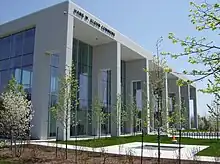
In 1964, the University of New Brunswick created UNB Saint John in buildings throughout the uptown CBD. In 1968, UNBSJ opened a new campus in the city's Tucker Park neighbourhood. This campus has undergone expansion over the years and is the fastest-growing component of the UNB system, with many new buildings constructed from the 1970s to the first decade of the 21st century. A trend in recent years has been a growth in the number of international students. The city also hosts a New Brunswick Community College campus in the East End of the city. There has also been a satellite campus of Dalhousie Medical School added within the UNBSJ campus in 2010, instructing 30 medical students each year.
In the fall of 2007, a report commissioned by the provincial government recommended UNBSJ and the NBCC be reformed and consolidated into a new polytechnic post-secondary institute. The proposal immediately came under heavy criticism and led to the organizing of several protests in the uptown area, citing the diminishment of UNB as a nationally accredited university, the reduction in accessibility to receive degrees – and these are only a couple of the reasons why the community was enraged by the recommendation. Support for keeping UNBSJ as it was, and expanding the university under its current structure, fell slightly below 90%. Seeing too much political capital would be lost, and several Saint John MPs were likely not to support the initiative if the policies recommended by the report were legislated, the government abandoned the commission's report and created an intra-provincial post-secondary commission.
Labour
Canada's first trade union
Saint John is often described as the birthplace of unionism in Canada and is one of the few pre-capitalist colonial settlements in North America. The city has a history of labour achievements and sparked the Canadian labour movement with Canada's first trade union, the Labourers' Benevolent Association (now International Longshoremen's Association Local 273). In 1849 the union was formed when Saint John's longshoremen banded together to lobby for regular pay and a shorter workday. One of their first resolutions was to apply to the city council for permission to erect the bell, which would announce the beginning and end of the labourers' 10-hour workday. As the bell shears were hardly finished when capitalists and merchants in the city objected to the bell and successfully lobbied city hall to keep the bell from being put up. But then, citizens and longshoremen defied the order and erected a larger bell and merchants withdrew their opposition to the "Labourers' Bell". ILA Local 273 remain one of the city's strongest trade unions to this day.[119]
The Saint John Street Railwaymen's strike and riot of 1914
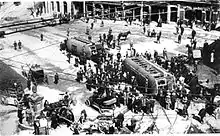
The 1914 Saint John street railway strike (sometimes called the Saint John street railwaymen's strike)[120] was a strike by workers on the street railway system in the city which lasted from July 22 to 24, 1914, with rioting by Saint John inhabitants occurring on July 23 and 24. The strike was important for shattering the image of Saint John as a conservative town dominated primarily by ethnic and religious (rather than class) divisions, and highlighting tensions between railway industrialists and the local working population.
October 14, 1976: The Saint John General Strike
The Saint John General Strike of 1976 was a result of the Bill C-73 passed by Prime Minister of Canada, Pierre Elliott Trudeau, and the House of Commons in Ottawa on October 14, 1975. This bill limited wage increases to 8% the first year, 6% the second year, and 4% the third year after its enactment. Most provinces of Canada accepted the bill by spring of 1976, but within eighteen months they began to withdraw from the program. After its introduction in 1975, it was not until 1976 that the Anti-Inflation Board (AIB) began to roll back workers' wages. The employees of Irving Pulp and Paper, members of the Canadian Paper Workers Union, were among the first to experience the roll backs implemented by the AIB. The paper workers were required to give back to the employer 9.8% of their previous wage increase the first year, and 11% the second year. The Atlantic Sugar Refinery workers of the Bakery and Confectionary Workers International Union of America soon felt the burden as well. The majority of workers within Saint John were influenced by the AIB by January 1976. On February 5, 1976, the Saint John District and the Labour Council held a conference to plan an organized opposition to the AIB. Fifty-two people came to the meeting as representatives of twenty-six unions in Saint John. The council was led by the Labour Council president, George Vair. They began by educating those present on wage control legislation, but swiftly transitioned into rallying and demonstrating in opposition throughout the city. Five thousand marched from numerous ends of the town to King Square. All major industries in Saint John were shut down.[121]
The Irving Oil Refinery strike, 1994–1996
On May 12, 1994, at 4:30 pm, members of Local 691 of the Communications, Energy and Paperworkers (CEP) union at the Irving Oil Ltd. Refinery went on strike. At this time the refinery's management took over its operations. Irving had argued the refinery might have to shut down and had to bring in a bevy of rollbacks to the workers’ pay and benefits and other changes to the collective agreement. Local 691 argued Irving simply wished to lengthen the work week without paying workers overtime rates. The strike lasted 27 months and was based on Irving's demands for flexibility of the workers to ensure the refinery was competitive. The strike is seen as symbolic of a rollback of labour and democratic collective bargaining rights that have been in decline across North America.[122]
Media
Television
Saint John's television market is served by two stations, those being CHNB-DT (Global) and CKLT-DT (CTV).[123] CHNB-DT is operated in Brunswick Square.[124]
Transportation


Air
Air service into Saint John is provided by the Saint John Airport/Aéroport de Saint John, near Loch Lomond 8 nautical miles (15 km; 9.2 mi) east northeast of the central business district[125] or approximately 25 km (16 mi) by road northeast of the city centre. Flights are offered by Sunwing Airlines (seasonal) and Air Canada (Air Canada Express and Air Canada Rouge). In 2011, WestJet decided to withdraw from the Saint John Airport. Quebec-based Pascan Aviation announced its expansion into Saint John in late 2012, with direct flights from Saint John to Quebec City, Newfoundland, and other destinations beginning in September 2012. Porter Airlines flies once daily from Saint John, to Ottawa and Toronto Island Airport.[126]
Highways
The main highway in the city is the Saint John Throughway (Route 1). Route 1 extends west to the United States border, and northeast towards both Prince Edward Island and Nova Scotia. A second major highway, Route 7, connects Saint John with Fredericton. There are two main road crossings over the Saint John River: the Harbour Bridge and the Reversing Falls Bridge, approximately 1 nautical mile (1.9 km) upstream.
Rail
The Reversing Falls Railway Bridge carries rail traffic for the New Brunswick Southern Railway on the route from Saint John to Maine. Saint John was serviced by the "Atlantic" Line of Via Rail passenger service. Passenger rail service in Saint John was discontinued in December 1994, although the Canadian National Railway and New Brunswick Southern Railway continue to provide freight service.
Port and ferries
Port Saint John is located where the Saint John River meets the Atlantic Ocean. Thus both the ocean and the river system is navigable from Saint John docks.[127] Bay Ferries operates a ferry service, MV Fundy Rose, across the Bay of Fundy to Digby, Nova Scotia. The Summerville to Millidgeville Ferry, a free propeller (as opposed to cable) ferry service operated by the New Brunswick Department of Transportation, connects the Millidgeville neighbourhood with Summerville, New Brunswick, across the Kennebecasis River on the Kingston Peninsula.
Public transit
Saint John Transit is the largest transit system in New Brunswick in both area coverage and ridership.[128] Bus service is provided by Saint John Transit (Greater Saint John Area) and Maritime Bus (Inter-city). Acadian Lines used to operate regular inter-city bus services between New Brunswick, Prince Edward Island, Nova Scotia, Bangor, as well as Rivière-du-Loup, Quebec (connecting with Orléans Express). Maritime Bus has since replaced Acadian Lines as the regional bus service.[129]
Culture
The city has always been a traditional hub for the arts on the east coast, boasting many notable artists, actors and musicians, including Walter Pidgeon, Donald Sutherland, Louis B. Mayer, and Miller Brittain. What is considered the golden age of the Saint John arts community was during the post-war era from 1940 to 1970 when the city produced renowned artists and writers such as poet Kay Smith, painters Jack Humphrey, Miller Brittain, Bruno Bobak, Fred Ross, and sculptor John Hooper and folk-singer Tom Connors. Poet Bliss Carman once wrote about Saint John, "All the beauty and mystery Of life were there, adventure bold, Youth, and the glamour of the sea, And all its sorrows old."[130]
Dance, music, and theatre
- Comhaltas Saint John: Comhaltas Ceoltóirí Éireann was founded in Dublin, Ireland, in 1951. Its mandate is to promote traditional Irish music and culture, and there are more than 400 branches around the world. The Saint John branch of Comhaltas is the easternmost chapter in Canada.
- JP Collins Celtic Festival: is an Irish festival celebrating Saint John's Irish heritage. The festival is named for a young Irish doctor James Patrick Collins who worked on Partridge Island quarantine station tending to sick Irish immigrants before he died there himself.
- Before the Mast: an a cappella men's vocal group that performs sea "shanties" from New Brunswick's past
- InterAction School of Performing Arts
- New Brunswick Youth Orchestra
- Open Arts – a series featuring post-classical and experimental music
- Saint John Rotary Boys' Choir – a boys' choir founded in 1965
- Saint John String Quartet – performs an annual chamber music concert series
- Symphony New Brunswick (SNB)- the province's only professional quality symphony orchestra.
- TD Station – Formerly Harbour Station, is a venue for large indoor concerts and events
- The Imperial Theatre
- Saint John Free Public Library, Library Millennium Artplace
- Third Space Gallery
- The Fundy Fringe Festival
- The Atlantic Repertory Company
- The Saint John Theatre Company
- The BMO Studio Theatre
Museums
- Hatheway Labour Exhibit Centre[131]
- Barbour's General Store
- New Brunswick Black History Society[132]
- Carleton Martello Tower
- Fort Howe
- Loyalist House
- New Brunswick Museum: Canada's first public museum.
- Saint John Firefighters Museum[133]
- Saint John Jewish Historical Museum
National Historic sites
Saint John is home to several National Historic Sites, including war fortifications such as the Carleton Martello Tower, a War of 1812 masonry tower, Fort Menagoueche, a former French fort from Father Le Loutre's War, Fort Howe, a British fort built during the American Revolution, and Fort La Tour. Other sites include the Imperial Theatre, the Loyalist House, the Saint John City Market, Partridge Island, the Prince William Streetscape, the Saint John Firefighters’ Museum and the Bank of New Brunswick.
_St..jpg.webp) Saint John is known for its pub and restaurant scene throughout uptown. Statistics Canada found the city has the third most pubs per capita in Canada[134]
Saint John is known for its pub and restaurant scene throughout uptown. Statistics Canada found the city has the third most pubs per capita in Canada[134].JPG.webp) The Imperial Theatre, a National Historic Site still hosting live performances
The Imperial Theatre, a National Historic Site still hosting live performances Fiddlehead sculpture at the Saint John Arts Centre in the city's uptown
Fiddlehead sculpture at the Saint John Arts Centre in the city's uptown Prince William Street, National Historic Site of Canada. The building in the foreground in the Bank of New Brunswick building, Canada's first bank established by Royal Charter
Prince William Street, National Historic Site of Canada. The building in the foreground in the Bank of New Brunswick building, Canada's first bank established by Royal Charter.jpg.webp) The Carleton Martello Tower, a Martello tower dating from the War of 1812
The Carleton Martello Tower, a Martello tower dating from the War of 1812
Music
Early settlers influenced music in Saint John from the time the area had been a series of forts for the English and French colonists. Working class fishers, labourers and shipbuilders carried Maritime traditions and folk songs with kitchen parties and outdoor gatherings. But musical high culture was captured by the wealthy. New Brunswick's solicitor-general 1784–1808, Ward Chipman Sr was known to have fancy soirées at his home with all the latest songs from London. A notable Loyalist musician, Stephen Humbert, moved in 1783 from New Jersey to Saint John and opened a Sacred Vocal Music School. In 1801 Humbert published Union Harmony, the first Canadian music book in English. The Mechanics' Institute, built in 1840, was the first large-scale platform for comic opera and concerts. In 1950 The Saint John Symphony was founded by Kelsey Jones; by 1983 the organization became Symphony New Brunswick. Some musicians from Saint John include Berkley Chadwick, Stompin' Tom Connors, Ken Tobias, Blank Banshee, Stevedore Steve,[135] Jane Coop, Bruce Holder, Frances James, the songwriter Michael F. Kelly, Ned Landry, the composer and teacher Edward Betts Manning, Paul Murray, Catherine McKinnon, Patricia Rideout, Philip Thomson, and the tenor and choir conductor Gordon Wry.[136]
Music festivals have long been a part of the city's cultural scene. New Brunswick's Music Festival was held in Saint John every Spring in the early- to mid-20th century.[137] As the city's music changed with the times, so did its festivals. Other popular festivals include the now defunct Festival By The Sea[138] and Salty Jam[139] catering to various genres of pop music.
The Area 506 music festival is held every New Brunswick Day long-weekend at Long Wharf on Saint John Harbour. The festival is set up with shipping containers from the port with vendors from New Brunswick companies to promote local business. A main stage area is also set up for night time shows with local acts as well as major groups. Major bands to have played Area 506 include Tegan and Sara, Stars, Bahamas, Interpol, and Arkells. Each year the festival also includes a bevy of bands coming out of the Saint John music scene.[140] Quality Block Party music festival hosts independent New Brunswick musicians in smaller venues throughout uptown Saint John. The festival gets its name from the old quality block on Germain Street.[141]
Sport

The following teams are based in Saint John:
- The Quebec Major Junior Hockey League's Saint John Sea Dogs 2011 & 2022 Canadian Hockey League Memorial Cup Champions
- The National Basketball League of Canada's Saint John Riptide
- The New Brunswick Rugby Union's Saint John Irish
- The New Brunswick Rugby Union's Saint John Trojans
- The New Brunswick Senior Baseball League's Saint John Alpines
The following sporting events have been held here:
- The 2022 Memorial Cup, the national tournament of the Canadian Hockey League took place here after two years of absence due to the pandemic, with the Saint John Sea Dogs winning the championship.
- The Saint John Flames of the AHL played here from 1993 to 2003, winning the Calder Cup in 2000–2001
- 1999 World Curling Championships (Men and Women) & 2014 World Women's Curling Championship
- 1998 World Junior Figure Skating Championships
- 1997 AHL All-Star Game
- 1995 Skate Canada International
- 1988 World Blitz Chess Championship[142]
- 1985 Canada Games
Notable people
- Louis B. Mayer - Canadian-American film producer and co-founder of Metro-Goldwyn-Mayer studios (MGM), grew up in Saint John, New Brunswick[143]
- Walter Pidgeon - Canadian-American actor. Born in Saint John.[144]
- Donald Sutherland - Canadian actor whose film career spans over eight decades, born 17 July 1935, in Saint John, New Brunswick.[145]
- Jim Doherty - Harness racing trainer-driver elected to both the U.S. Harness Racing Hall of Fame and the Canadian Horse Racing Hall of Fame; born in Saint John, New Brunswick, 27 September 1940[146][147]
- Elizabeth J. Smith – Born in Saint John. Social reformer; newspaper editor and publisher
- Laraine Frances Orthlieb - Born in Saint John. First female flag officer in the Canadian Armed Forces.
Twin/sister cities
 Koper, Slovenia[148][149]
Koper, Slovenia[148][149] Shantou, Guangdong, China[150]
Shantou, Guangdong, China[150]
See also
- Bank of New Brunswick: the first chartered bank in Canada.
- The Paris Crew: Canada's first international sporting champions (rowing), 1867.[151]
Notes
- This is the legal name in both English and French.
- While other cities were founded as communities earlier, Saint John was the first to be incorporated as a city.
- Based on station coordinates provided by Environment Canada, climate data recorded near downtown Saint John from January 1871 to September 1970, and at Saint John Airport from November 1946 to present.
- Statistic includes all persons that did not make up part of a visible minority or an indigenous identity.
- Statistic includes total responses of "West Asian" and "Arab" under visible minority section on census.
- Statistic includes total responses of "Chinese", "Korean", and "Japanese" under visible minority section on census.
- Statistic includes total responses of "Filipino" and "Southeast Asian" under visible minority section on census.
- Statistic includes total responses of "Visible minority, n.i.e." and "Multiple visible minorities" under visible minority section on census.
- Saint John was amalgamated with the nearby city of Portland in 1889.
- Saint John was amalgamated with the nearby city of Lancaster and Simonds Parish in 1967.
References
- Common Council Minutes - February 8, 2016
- "Territorial Divisions Act (section 27(a))". The Province of New Brunswick, through the Queen’s Printer. Retrieved 7 February 2016.
- McGahan, Elizabeth W. "Saint John".
- "Census Profile, 2021 Census: Saint John, New Brunswick". Statistics Canada. Retrieved 30 July 2022.
- "Statistics Canada, 2021 Census of Population". Statistics Canada. Retrieved 24 May 2023.
- "Census Profile, 2021 Census: Saint John [Census metropolitan area], New Brunswick". Statistics Canada. Retrieved 30 July 2022.
- "Saint John". Geographical Names Data Base. Natural Resources Canada.
- "Table 36-10-0468-01 Gross domestic product (GDP) at basic prices, by census metropolitan area (CMA) (x 1,000,000)". Statistics Canada. 27 January 2017. Archived from the original on 22 January 2021. Retrieved 27 April 2021.
- "Saint John, NB". Canadian Encyclopedia. Retrieved 12 June 2017.
- "Port Saint John reports 2016 tonnage". Archived from the original on 28 July 2017. Retrieved 23 July 2017.
- "Census Profile, 2021 Census". www12.statcan.gc.ca. Statistics Canada. Retrieved 30 July 2022.
- MacDonald (1983). Fortune & La Tour: The civil war in Acadia. Toronto: Methuen.
- "Saint John". Canadian Encyclopedia. Retrieved 26 July 2020.
- Canada's First City: Saint John. Saint John, N.B.: Lingley Printing. 1962. p. 30.
- "The Ship Marco Polo". Retrieved 30 July 2017.
- "Famous Glaswegians – Robert Foulis, Jr". Glasgow Guide. Retrieved 24 August 2019.
- "For Whom The Bells Toll". Hatheway Labour Exhibit Center.
- Winder, Gordon M. (2000). "Trouble in the North End: The Geography of Social Violence in Saint John 1840–1860". Acadiensis. XXIX (2 Spring): 27.
- Bilson, Geoffrey (1974). "The Cholera Epidemic in Saint John, N.B., 1854". Acadiensis. 4 (1): 85–99.
- Collins, Donald (20 June 2002). "Weary city resurfaces from ashes: In the weeks and months following the Great Fire of 1877, Saint John people and businesses persevered". newbrunswick.net. Telegraph-Journal (New Brunswick). Retrieved 25 June 2014.
- Scientific American, "St. John, N.B., Burned". Munn & Company. 7 July 1877. p. 3.
- "Census Profile, 2016 Census". www12.statcan.gc.ca. Statistics Canada. Retrieved 3 January 2021.
- Arif, Hassan (21 July 2016). "Saint John: Photos of an underappreciated city". Spacing Atlantic. Retrieved 28 August 2023.
- "Music of the Eye II: Architectural Drawings of Saint John and Its Region". NBM-MNB. New Brunswick Museum. Retrieved 28 August 2023.
- Wright, Julia (27 April 2018). "The story behind Saint John's strange stone carvings". CBC. Retrieved 28 August 2023.
- "Visit Saint John and Discover Saint Awesome". MARITIMES MAVEN. 26 August 2020. Retrieved 28 August 2023.
- "Commercial Properties". Archived from the original on April 19, 2012.
- "JD Irving".
- "Canada". www.cbre.ca.
- "Home". www.chateausaintjohn.ca.
- "King's Square". King’s Square | City of Saint John, New Brunswick.
- "Irving Nature Park". Irving Nature Park | City of Saint John, New Brunswick.
- "Explore the Irving Nature Park | Discover Saint John". www.discoversaintjohn.com.
- "Neighbourhoods". catalogue-saintjohn.opendata.arcgis.com. Retrieved 2 October 2023.
- "Neighbourhoods". saintjohn.ca. City of Saint John. Retrieved 2 October 2023.
- "North End". North End. City of Saint John. 26 June 2022. Retrieved 2 October 2023.
- "Provincial Archives of New Brunswick". archives.gnb.ca. Retrieved 2 October 2023.
- "Millidgeville/Cedar Point". Millidgeville/Cedar Point. City of Saint John. 15 May 2022. Retrieved 2 October 2023.
- "Provincial Archives of New Brunswick". archives.gnb.ca. Retrieved 2 October 2023.
- "Demolition of Mount Pleasant homes is 'quite sad'". CBC. 8 July 2013. Retrieved 2 October 2023.
- "Provincial Archives of New Brunswick". archives.gnb.ca. Retrieved 2 October 2023.
- "Brookville/Glen Falls". Brookville/Glen Falls. City of Saint John. 24 April 2022. Retrieved 2 October 2023.
- "East Saint John/ McAllister". East Saint John/ McAllister. City of Saint John. 14 August 2022. Retrieved 2 October 2023.
- "Provincial Archives of New Brunswick". archives.gnb.ca. Retrieved 2 October 2023.
- "Champlain Heights/Eastwood". Champlain Heights/Eastwood. City of Saint John. 24 April 2022. Retrieved 2 October 2023.
- "Provincial Archives of New Brunswick". archives.gnb.ca. Retrieved 2 October 2023.
- "Red Head". Red Head. City of Saint John. 15 May 2022. Retrieved 2 October 2023.
- "Provincial Archives of New Brunswick". archives.gnb.ca. Retrieved 2 October 2023.
- "Provincial Archives of New Brunswick". archives.gnb.ca. Retrieved 2 October 2023.
- "Forest Hills/Lakewood". Forest Hills/Lakewood. City of Saint John. 1 August 2022. Retrieved 2 October 2023.
- "Provincial Archives of New Brunswick". archives.gnb.ca. Retrieved 2 October 2023.
- "Provincial Archives of New Brunswick". archives.gnb.ca. Retrieved 2 October 2023.
- "Loch Lomond/Latimer Lake". Loch Lomond/Latimer Lake. City of Saint John. Retrieved 2 October 2023.
- "Provincial Archives of New Brunswick". archives.gnb.ca. Retrieved 2 October 2023.
- "City Gets Glimpse Of What Saint Johners Think About South Central Peninsula". Country 94. Retrieved 2 October 2023.
- "South Central Peninsula". South Central Peninsula. City of Saint John. 3 April 2022. Retrieved 2 October 2023.
- "Provincial Archives of New Brunswick". archives.gnb.ca. Retrieved 2 October 2023.
- Desk, Atlantic Briefs (11 August 2023). "New 45-unit apartment complex with 23 affordable units proposed for Waterloo Village in Saint John, N.B. | SaltWire". www.saltwire.com. Retrieved 2 October 2023.
- "Provincial Archives of New Brunswick". archives.gnb.ca. Retrieved 2 October 2023.
- "Provincial Archives of New Brunswick". archives.gnb.ca. Retrieved 2 October 2023.
- "Saint John West". Saint John West. City of Saint John. 10 July 2022. Retrieved 2 October 2023.
- "Sand Cove". Sand Cove. City of Saint John. Retrieved 2 October 2023.
- "Provincial Archives of New Brunswick". archives.gnb.ca. Retrieved 2 October 2023.
- "Provincial Archives of New Brunswick". archives.gnb.ca. Retrieved 2 October 2023.
- "Island View/Fairville". Island View/Fairville. City of Saint John. Retrieved 2 October 2023.
- "Provincial Archives of New Brunswick". archives.gnb.ca. Retrieved 2 October 2023.
- "Provincial Archives of New Brunswick". archives.gnb.ca. Retrieved 2 October 2023.
- "Ocean Westway/Lorneville". Ocean Westway/Lorneville. City of Saint John. Retrieved 2 October 2023.
- "Milford Randolph". Milford Randolph. City of Saint John. 24 April 2022. Retrieved 2 October 2023.
- "Provincial Archives of New Brunswick". archives.gnb.ca. Retrieved 2 October 2023.
- "Provincial Archives of New Brunswick". archives.gnb.ca. Retrieved 2 October 2023.
- "South Bay". South Bay. City of Saint John. 24 April 2022. Retrieved 2 October 2023.
- "Provincial Archives of New Brunswick". archives.gnb.ca. Retrieved 2 October 2023.
- "Saint John A". Canadian Climate Normals 1971–2000. Environment Canada. 19 January 2011. Retrieved 30 September 2013.
- "Daily Data Report for June 1941". Canadian Climate Data. Environment Canada. 22 September 2015. Retrieved 26 June 2016.
- "Daily Data Report for August 1944". Canadian Climate Data. Environment Canada. 22 September 2015. Retrieved 26 June 2016.
- "Saint John A". Canadian Climate Normals 1981–2010. Environment Canada. 31 October 2011. Retrieved 12 May 2014.
- "Saint John A". Canadian Climate Normals 1981–2010. Environment Canada. Archived from the original on 31 October 2020. Retrieved 30 September 2013.
- "Saint John". Canadian Climate Data. Environment Canada. 31 October 2011. Retrieved 26 June 2016.
- "Hourly Data Report for March 21, 2012". Canadian Climate Data. Environment Canada. 31 October 2011. Retrieved 26 June 2016.
- "Daily Data Report for March 2012". Canadian Climate Data. Environment Canada. 31 October 2011. Retrieved 26 June 2016.
- Wallace, C. M. (June 1975). "Saint John, New Brunswick (1800-1900)". Urban History Review / Revue d'Histoire Urbaine. 4 (1): 12–21. doi:10.7202/1020578ar. JSTOR 43558749.
- Government of Canada, Statistics Canada (9 February 2022). "Ranking of the 10 most populated municipalities, 1901 to 2021". www12.statcan.gc.ca.
- Marquis, Greg (1 January 2010). "Uneven Renaissance: Urban Development in Saint John, 1955-1976". Journal of New Brunswick Studies / Revue d’études sur le Nouveau-Brunswick.
- Government of Canada, Statistics Canada (9 February 2022). "Profile table, Census Profile, 2021 Census of Population - Saint John, City (C) [Census subdivision], New Brunswick". www12.statcan.gc.ca.
- "Population and dwelling counts: Canada, provinces and territories, census metropolitan areas and census agglomerations". Statistics Canada. 9 February 2022. Retrieved 28 March 2022.
- "Before Willie O'Ree: New Brunswick's surprising black history contributions". CBC. Retrieved 10 November 2019.
- Thomas P. Power, ed., The Irish in Atlantic Canada, 1780-1900 (Fredericton, NB: New Ireland Press, 1991)
- Government of Canada, Statistics Canada (26 October 2022). "Census Profile, 2021 Census of Population". www12.statcan.gc.ca. Retrieved 19 May 2023.
- Government of Canada, Statistics Canada (27 October 2021). "Census Profile, 2016 Census". www12.statcan.gc.ca. Retrieved 19 May 2023.
- Government of Canada, Statistics Canada (27 November 2015). "NHS Profile". www12.statcan.gc.ca. Retrieved 19 May 2023.
- Government of Canada, Statistics Canada (20 August 2019). "2006 Community Profiles". www12.statcan.gc.ca. Retrieved 19 May 2023.
- Government of Canada, Statistics Canada (2 July 2019). "2001 Community Profiles". www12.statcan.gc.ca. Retrieved 19 May 2023.
- Government of Canada, Statistics Canada (8 May 2013). "2011 National Household Survey Profile - Census subdivision". www12.statcan.gc.ca. Retrieved 14 January 2023.
- "Is 'Charter-City Status' a Solution for Financing City Services in Canada — Or is that a Myth?" (PDF). University of Calgary. Retrieved 21 August 2018.
- "Institutional Discrimination in the 1785 Saint John Royal Charter". UNB. Retrieved 4 August 2020.
- "Geography and Governance: The Problem of Saint John (New Brunswick) 1785 - 1927 - Ged Martin". www.gedmartin.net.
- Hale, C. Anne. "The Rebuilding of Saint John New Brunswick 1877-1881" (PDF).
- "Saint John". www.thecanadianencyclopedia.ca.
- "Strategic Winter Port: A History of the Port of Saint John | Canadian Museum of Immigration at Pier 21". pier21.ca.
- "Saint John | History & Points of Interest | Britannica". www.britannica.com.
- "Irving family closing idled Saint John shipyard". CBC News. 27 June 2003. Retrieved 31 July 2023.
- "Saint John Shipyard and Dry Dock Co Ltd". www.unb.ca. University of New Brunswick. Retrieved 31 July 2023.
- "DISCOVER SAINT JOHN 2018 ANNUAL REPORT" (PDF). www.discoversaintjohn.com. Discover Saint John. Retrieved 31 July 2023.
- "CRUISE LINES". Port Saint John.
- McGillivray, Robert (26 September 2022). "Canada Cruise Port Reaches Major Passenger Milestone". Cruise Hive.
- Wright, Julia (8 June 2023). "Meet the marine pilots guiding huge ships into Saint John's notoriously difficult port". CBC News. Retrieved 31 July 2023.
- "Cruise Schedule". Port Saint John.
- "ANNUAL REPORT 2022" (PDF). Port Saint John. Retrieved 1 August 2023.
- "Saint John Port". World Port Source. Retrieved 10 January 2019.
- "Port Saint John". www.sjport.com/.
- "Facilities: Hospitals". Horizon Health Services. Retrieved 26 August 2019. Hospitals in the Saint John Region: Charlotte County Hospital, Grand Manan Hospital, Saint John Regional Hospital, St. Joseph's Hospital and Sussex Health Centre.
- "Marine Biology". UNB. Retrieved 11 July 2020.
- "Cooke Seafood". Retrieved 11 July 2020.
- "Port Saint John". Retrieved 5 April 2019.
- "LinkedIn Login, Sign in". LinkedIn.
- Government of New Brunswick, Canada (30 October 2014). "Anglophone School District Information". www2.gnb.ca.
- "Schools". Schools | City of Saint John, New Brunswick.
- "For Whom The Bells Toll". Hatheway Labour Exhibit Center. Retrieved 6 May 2017.
- Babcock, Robert H. (January 1982). "The Saint John Street Railwaymen's Strike and Riot, 1914". Acadiensis. University of New Brunswick. 11 (2). ISSN 0044-5851. Retrieved 13 May 2016.
- "Canadian workers strike against wage controls, 1976". Retrieved 6 May 2017.
- Steuter, Erin; Martin, Geoff. "The Myth of the Competitive Challenge: The Irving Oil Refinery Strike, 1994–96 and the Canadian Petroleum Industry". Retrieved 6 May 2017.
- "Stations for Saint John, New Brunswick". www.rabbitears.info.
- "CHNB-DT | History of Canadian Broadcasting". broadcasting-history.com.
- Canada Flight Supplement. Effective 0901Z 16 July 2020 to 0901Z 10 September 2020.
- "PASCAN Aviation confirms its schedule of flights from Saint John, NB starting September 17". Canada Newswire. Archived from the original on April 2, 2015. Retrieved August 9, 2012.
- "Facilities and Operations". Port Saint John. 10 May 2016. Retrieved 11 April 2020.
- "Organization". Saint John Transit. Retrieved 15 June 2021.
- "UARB names bus company to replace Acadian Lines". Rogers. Retrieved 11 April 2020.
- "Saint John: City of Firsts". Maclean's.
- "Frank & Ella Hatheway Labour Exhibit Centre".
- "New Brunswick Black History Society".
- "Visit the Saint John Firefighter's Museum".
- "Cheers, Saint John: Port City Has Third Most Bars Per Capita In Country". Acadia Broadcasting Ltd. Archived from the original on 5 February 2018. Retrieved 4 February 2018.
- "Stevedore Steve, writer of Lester the Lobster, dead at 80". Retrieved 30 July 2017.
- "Music in Saint John". Retrieved 30 July 2017.
- "Salty Jam . July 5&6 . Headliners Announced - Uptown Saint John". Maclean's. Archived from the original on 13 November 2019. Retrieved 13 November 2019.
- "Annual Festivals". Retrieved 13 November 2019.
- "Salty Jam . July 5&6 . Headliners Announced - Uptown Saint John". Uptown Saint John. Archived from the original on 13 November 2019. Retrieved 13 November 2019.
- "Saint John waterfront transformed into shipping container village for Area 506 festival". Retrieved 2 August 2017.
- "Quality Block Party vies for status as 'destination festival'". CBC. Retrieved 8 April 2018.
- Goodman, David (20 February 1988). "World Champion Eliminated From Blitz Chess Tournament". Associated Press. Retrieved 26 January 2017.
- "Britannica: Louis B. Mayer". 30 June 2023.
- "imdb: Walter Pidgeon". IMDb.
- "Britannica: Donald Sutherland". IMDb.
- "Hall of Fame". Harness Racing Museum. Retrieved 6 August 2023.
- "Jim Doherty". Canadian Harness Racing Hall of Fame. Retrieved 6 August 2023.
- "Report: Visit of the Honourable Noël A. Kinsella, Speaker of the Senate, and a Parliamentary Delegation, to the Holy See, Romania and Slovenia" (PDF). Parliament of Canada. p. 17. Archived from the original (PDF) on 14 February 2017. Retrieved 10 January 2019.
- "Saint John – The city has a twin on the Adriatic Sea". Retrieved 10 January 2019.
- Government of Canada, Foreign Affairs Trade and Development Canada. "Canada China Twinning Relationships".
- Irving, Margaret. "Paris Crew". The Canadian Encyclopedia. Retrieved 10 July 2017.
